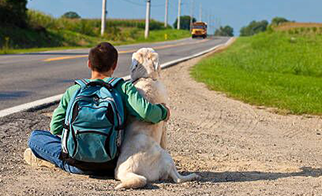Back to School Tips for Pets
Topics | Back to School
Posted | July 29, 2019

While the kids are getting prepared to go back to school it's important not to forget about the
family pet. The change between summer and school is a big difference for the pet that is used to
you being home all day. Suddenly, they are alone and might feel lonely or sad. This can lead to
destructive behavior simply because you didn't prepare. Start preparing early and when school
starts, your pet is ready.
Pets may experience the effects of the loss of playtime and bonding they developed with the
children by exhibiting signs of separation through destructive behaviors, such as:
- Chewing on furniture and ripping pillows
- Shredding paper and other objects
- Obsessive barking, crying for long periods of time
- House soiling
Here are a few helpful hints for the kids to help them adjust:
- Avoid emotional hellos and good-byes. Instead, give them a lot of loving when you
wake up. It might require getting up earlier and take him for a walk (for dogs). A
quick "see ya" when you leave is what your pet needs to relax and wait for your return.
- Every once in a while, pretend you are leaving and don't. Pick up your bag, go
out the door and then come back in. They will soon learn to relax when you leave.
- Leave behind an old t-shirt for them to cuddle up with.
- Leave toys for your pets while you're gone. Interactive toys alleviate boredom.
Most destructive behavior is a result of boredom.
- Go for a walk when you get home, it's quality time together and good
exercise for both of you. Invite a friend, human or dog along for companionship.
- When doing your homework, read it to your pet. They love the attention!
- Groom and brush them often. Talk to your pets while you are brushing them.
- Include them in your games, soccer, basketball, etc. It's great exercise for both of you.
Be sure to check with your veterinarian to have your dog fully evaluated and
correctly diagnosed before trying to manage the symptoms. There may be an
underlying medical condition that may be misconstrued as separation anxiety.








